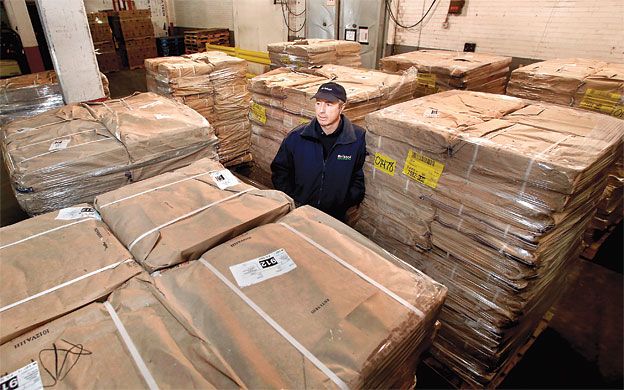Cold storage needed to boost new shipping service
 PHOTo / Tim greenway
Darrell Pardy, president of Bristol Seafood, among pallets of Bristol Seafood's frozen haddock at Americold in Portland
PHOTo / Tim greenway
Darrell Pardy, president of Bristol Seafood, among pallets of Bristol Seafood's frozen haddock at Americold in Portland
When Icelandic container shipping service Eimskip arrived at Portland's International Marine Terminal on March 29 with its first shipment — bottled water and frozen fish — it received a warm welcome in a city where inconsistent container service has stymied attempts to build robust import/export operations.
But warmth takes a backseat to cold when it comes to growing the port into a major East Coast shipping hub, according to Darrell Pardy, president of Portland-based Bristol Seafood.
“The immediate issue is: Is there enough cold storage infrastructure in Portland to handle [new business]?” asks Pardy, whose business relies on frozen seafood imports that it processes into fillets and ships to customers throughout North America.
As Iceland's largest shipping service, Eimskip operates 20 vessels in the North Atlantic, services some of Northern Europe's busiest ports and expects to bring about 5,000 containers through Portland each year. For now, the city will be Eimskip's only U.S. port of call, with company officials hinting at a probable relocation of their North American corporate offices from Virginia Beach, Va., to Portland.
Some trade experts say the arrival of Eimskip, with its specialty in frozen-seafood shipping, holds promise for the city and could spur a renaissance in seafood processing in a region that has been without consistent, direct container service to Europe for the last 33 years.
“The influence on imports and exports for seafood and the food products industry could be very large,” says Maine International Trade Center President Janine Cary. “Eimskip is very much known for its cold supply chain and I'm hopeful that it will bring more seafood processing as well as new capabilities.”
But some seafood processors, like Pardy, say that Portland might not have the cold storage capacity to handle increased seafood imports, which require consistent cold temperatures to ensure freshness as seafood moves from the ocean to processors and, eventually, dining room tables.
Many of Maine's seafood processors find it more economical to use out-of-state cold storage facilities, but as the Icelandic shipping company settles into its new home, several cold storage companies have begun to reassess Portland's potential for storing seafood imports.
“There is going to need to be more cold storage capacity, and the opportunity is certainly there, but the question is whether [importers] see the Maine market as the place to locate and how much of the product brought into Portland is actually going to stay here,” says Pardy, a 20-year veteran of the Maine seafood industry.
Portland is now served by a single cold storage facility — the 1.7 million cubic-foot Americold Logistics warehouse on Read Street — which Bristol uses to complement its primary cold storage units, in the Boston area.
Pardy says Americold has reserved guaranteed capacity for Bristol, Maine's largest importer of Norwegian haddock, and will be used by Bristol “a lot more going forward.” But he warns, “If people want to keep the bulk of their products here, cold storage could become an issue.”
Eimskip is working with the Maine Port Authority — which leases the International Marine Terminal from the city of Portland — to install 150 refrigerated container plugs (power sources) at the site. The $300,000 investment, paid by the Maine Department of Transportation and the Maine Port Authority, will help to keep refrigerated containers cold and will “enable Eimskip to undertake a full discharge of the vessel in order to minimize the time the vessel is in port,” according to John Henshaw, the port authority's executive director.
“This additional capacity will complement cold storage capacity for our region, but will not replace it,” Henshaw says.
Out-of-state competition
Americold's cold storage facility is one of just 18 in the state. The number of Maine facilities has held relatively stable over the last 20 years, but their overall capacity fell by 20% over that time period, according to the U.S. Department of Agriculture's biennial Capacity of Refrigerated Warehouses survey. By comparison, Massachusetts has 59 cold storage facilities and has seen its overall capacity rise by 73% in the last 20 years.
Given that an estimated 35% of Eimskip's imports are frozen seafood, Americold “has indicated that they will invest in their current cold storage to attract business of the Eimskip vessel,” according to Larus Isfeld, Eimskip USA's managing director.
The size and scale of the upgrade are unknown, as is whether it will be adequate to spur additional business. Americold did not respond to questions from Mainebiz about the upgrade.
“There is a lot of stuff going to Boston that can be captured by Portland if they have a state-of-the-art cold storage facility,” says Cary.
Whether there are equal opportunities for Maine seafood businesses on the export side of the equation is murky.
Shuck's Maine Lobster COO Charlie Langston says the lobster processor stores most of its product in Boston because of a lack of space at the company's Richmond location. Historically, exports have accounted for 25% of Shuck's sales, so it relies more on land-based transportation for the majority of its domestic deliveries. Additionally, the company benefits from Boston's easy highway access for truckers and plenty of cold storage facilities, says Langston. For Portland to become a viable trade center, “that trucking aspect would have to be solved,” he says.
Still, Langston says Eimskip's arrival in Portland has piqued his interest, and the company is likely to export several containers of lobster from Portland to customers in Europe.
New investment needed?
MITC's Cary says some of Portland's cold chain infrastructure was lost over the last decade as the volume of seafood coming through the port dwindled because of smaller groundfish catches. The city of Portland floated a request for qualifications to build a new deep cold storage facility at the Portland Fish Pier in late 2010 after discussions between the city and seafood industry representatives identified more cold storage as key to that industry's growth.
“The Portland facility [is] still in operation, but is not sufficient to serve the needs of the frozen seafood industry, which requires deep temperatures of -20 to -30 degrees to preserve product,” reads the text of the RFQ.
The RFQ yielded just two responses, according to Portland Economic Development Director Greg Mitchell. That lack of interest and market uncertainty led the city to abandon the project, he says.
“I think the addition of containerized cargo service associated with Eimskip creates an opportunity to revisit that discussion,” says Mitchell, although he acknowledges, “We don't have a lot of real estate on the waterfront to accommodate something like that.”
In 2011, two Massachusetts-based cold storage companies explored expansion into the Portland market, but ultimately decided the port did not have the volume of business to support the investment. With the arrival of Eimskip, both say they are reassessing the city's potential.
“I think it's definitely worth us doing our due diligence again because Eimskip should increase the need for frozen [storage],” says Clement DeLiso, president of Pioneer Cold Logistics in Chicopee, Mass.
But DeLiso says he doesn't anticipate a “huge increase in the need” for cold storage in Portland because of Boston's stronghold on northern New England's cold storage facilities.
Brian Beattie, executive vice president of sales at Preferred Freezer Services in Westfield, Mass., agrees that Portland will have to step up its game to compete with Boston. The city still lacks the critical mass of trade needed to sustain a facility, says Beattie, although he intends to keep an eye on whether Eimskip's arrival makes Portland more attractive in the future.
“It's not clear whether this will change the overall market capacity, so it's a risk to invest in the market at this point,” he says.
Instead, he wonders how Preferred might lure Eimskip's cargo of frozen fish from Portland to cold storage facilities in Massachusetts.
“We are looking at [how] their products would be transported from Maine to one of our locations,” most likely in Everett, Mass., says Beattie.
But Tori Miller Liu, director of communications with industry group Global Cold Chain Alliance, says that a strong Boston-area cold storage market does not preclude Portland from getting into the game.
“Portland certainly could make inroads in the cold storage industry. There are many regions — like Atlanta and Macon [Georgia] — where refrigerated warehouse facilities are located within 100-200 miles of each other and both receive sufficient business to justify the cost,” she says.
Four critical factors play into any new cold storage development, according to Liu: capital, demand, land, and infrastructure. By some assessments, the city lacks adequate ocean-front land and Americold is the only established cold storage infrastructure, leaving capital and demand as the two question marks.
“Proximity to other facilities is certainly a factor to consider, but it's not prohibitive to setting up operations,” she says.
Whether Portland develops enhanced cold storage capacity is only a tangential concern to Pardy of Bristol Seafood. The assurance that Americold will meet its needs, coupled with Eimskip's new service, puts the company in a good place.
“This creates a huge opportunity for us because having the product sitting right on our doorstep is great,” says Pardy, whose company is on Portland's waterfront. “Now we are the first point of entry rather than being two hours north.”














Comments